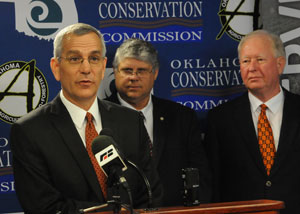Oklahoma Leads Nation Again in Water Quality
Oklahoma ranked number one among all states in controlling harmful nutrients in water for the second year in a row according to recently-released EPA numbers; Fourth year in a row for state to be in the top ten.

A recent comparison of EPA priority nonpoint source pollutant reduction numbers from across the nation shows that Oklahoma again ranks as the number one state when it comes to reducing harmful nutrients from our streams and rivers. This is the second year in a row that Oklahoma has ranked number one among states in reported nonpoint source nutrient reductions and the fourth year for the state to be in the top ten.
State Sec. of Agriculture Jim Reese, several legislators, the Oklahoma Conservation Commission, the Oklahoma Association of Conservation Districts and two farm organizations held a news conference at the state Capitol on April 2, 2013, to announce the news.
“For the second year in a row, we have reduced nutrients to streams using our EPA Nonpoint Source Program more than any other state,” Sec. Reese said. “Oklahoma is the leader in the United States of America in removing nitrogen and phosphorous from our waterways. “
“This continued improvement in addressing water quality is a testimony to the success of the dedicated work done by farmers, ranchers and other landowners in partnership with the Oklahoma Conservation Commission, local conservation districts and the USDA Natural Resources Conservation Service (NRCS) to address this critical issue,” according to Kim Farber, president of the Oklahoma Association of Conservation Districts (OACD). “This success shows what can happen when we work together, respect individuals’ private property rights and when the state and federal governments give landowners the financial and technical assistance they need to make changes. Locally-led, voluntary conservation works,” Farber said.
Water quality numbers recently reported by states to the Environmental Protection Agency (EPA) show that in 2012, Oklahoma’s Nonpoint Source Program led the nation in phosphorus reduction with more than 2,443,752 pounds of estimated phosphorus load reduced due to voluntary best management practices across the state. In addition, Oklahoma ranked first among the states in reducing nitrogen loading, reducing an estimated 2,695,211 pounds of nitrogen last year.
Oklahoma also had a estimated sediment reduction of over 10,000 tons. When these numbers are reviewed in EPA’s national Nonpoint Source Database, comparison with the levels of nonpoint source pollution reduced by other states shows that Oklahoma ranks number one in the reduction of nutrients that pollute our water. This is the second year in a row in which Oklahoma has led the nation in reduction of nutrients while receiving less than three percent of all federal EPA nonpoint source pollution funds.
“We appreciate the efforts of Oklahoma landowners who are installing and maintaining conservation practices on the land that help protect our waters,” said Mike Thralls, Oklahoma Conservation Commission executive director. “By having a water quality monitoring program we are able to document water quality improvements.”
According to Clay Pope, OACD executive director, this reduction shows the success of locally-led conservation efforts in addressing non-point source pollution and helps highlight why locally-led incentive-based programs are critical to ongoing efforts designed to address water quality both at the state and federal level.
“By using the delivery system consisting of the Oklahoma Conservation Commission, local conservation districts and NRCS, we have been able to use federal Clean Water Act and Farm Bill Conservation Title funds along with state dollars to partner with landowners in ways that are starting to turn the comer on some of Oklahoma’s toughest water quality problems,” Pope said. “We’re not only controlling pollution, but we are also taking into consideration the financial situation of the local landowner. This is the same kind of approach we used to tame the Dust Bowl of the 1930s and these numbers show it’s working again in the water quality area. Clearly, we have a great model and it needs to be included in discussions surrounding water both in Oklahoma and the nation. You can have all the water in the world, but if it isn’t fit to drink, you don’t have much. These numbers prove that we are moving in the right direction in Oklahoma when it comes to water quality and we hope that our policymakers will continue to recognize what can be done when landowners and the government work cooperatively to solve these kinds of problems.”
Also participating in the news conference were state Representatives Dale DeWitt, Don Armes and Steve Vaughn; Sen. Eddie Fields; John Mueller, state conservationist for the USDA Natural Resources Conservation Service; Mike Spradling, president of the Oklahoma Farm Bureau; and Terry Detrick, president of American Farmers and Ranchers.
